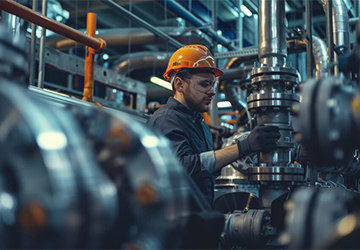Maximizing Pump Efficiency: A Simple Guide to Pump System Optimization
Understanding Pump Efficiency Pump efficiency serves as a crucial metric for assessing the relationship between energy input and useful energy output. Essentially, it quantifies how effectively a pump converts supplied energy into the desired flow and pressure. Improving pump efficiency can lead to significant cost savings, reduced energy consumption, and enhanced overall system performance. Factors Affecting Pump Efficiency Several factors influence the efficiency of a pump system, including: Pump Design and Impeller Selection: The design and choice of impeller play a vital role in determining pump efficiency. System Design and Piping Configuration: The layout and configuration of the piping system can significantly impact pump performance. Operating Conditions: Variables such as flow rate and head pressure affect the efficiency of pump operation. Maintenance and Wear of Pump Components: Regular maintenance and timely replacement of worn components are crucial. Proper System Balancing and Control: Ensuring the system is balanced and appropriately controlled enhances efficiency. Understanding these factors and their interplay is essential for optimizing pump efficiency. Importance of Pump System Optimization Optimizing pump systems is imperative for several reasons: Energy Savings: Enhanced pump efficiency leads to significant energy consumption reductions, lowering operating costs and promoting sustainability. Increased Reliability: Optimized systems are less prone to breakdowns and require fewer maintenance interventions, improving reliability and uptime. Enhanced Performance: Efficient pump systems deliver the desired flow and pressure more effectively, boosting overall process performance and productivity. Environmental Impact: Reduced energy consumption and improved reliability decrease the environmental footprint, supporting sustainability initiatives Steps to Maximize Pump Efficiency Proper Pump Selection and Sizing: Analyze system requirements meticulously and select the appropriate pump size and type for the application. Avoid oversizing pumps to prevent inefficient operation and increased energy consumption. Regular Maintenance and Troubleshooting: Implement a comprehensive maintenance program to keep pumps in optimal condition. Address issues such as wear, corrosion, and impeller imbalance promptly to maintain efficiency. Regularly monitor pump performance to identify and rectify potential problems early. Energy-Saving Techniques: Implement variable frequency drives (VFDs) to match pump output to system demand. Upgrade to more energy-efficient pumps or replace older, less efficient models. Optimize system piping and valve configurations to minimize friction losses and enhance overall system efficiency. System Balancing and Control: Ensure proper system balancing to keep each pump operating within its optimal efficiency range. Implement advanced control systems to adjust pump speed and output dynamically based on changing system requirements. Continuous Monitoring and Optimization: Continuously monitor pump performance and system parameters to identify further optimization opportunities. Regularly review and adjust pump system settings and configurations to maintain peak efficiency. By implementing these steps, you can significantly enhance the efficiency of your pump systems, resulting in substantial energy savings, reduced operating costs, and improved overall system performance. Conclusion and Key Takeaways Maximizing pump efficiency is a cornerstone of effective pump system optimization. By understanding the factors affecting pump efficiency, adopting best practices for pump selection and maintenance, and leveraging energy-saving techniques, you can unlock significant benefits for your organization. Success lies in a holistic approach to pump system optimization, where continuous performance monitoring, identification of improvement areas, and necessary adjustments ensure pumps operate at peak efficiency. For more insights into optimizing your pump systems and maximizing efficiency, schedule a consultation with our team of pump system experts. We’ll collaborate with you to develop a customized plan tailored to your specific needs, helping you achieve your operational and sustainability goals.




